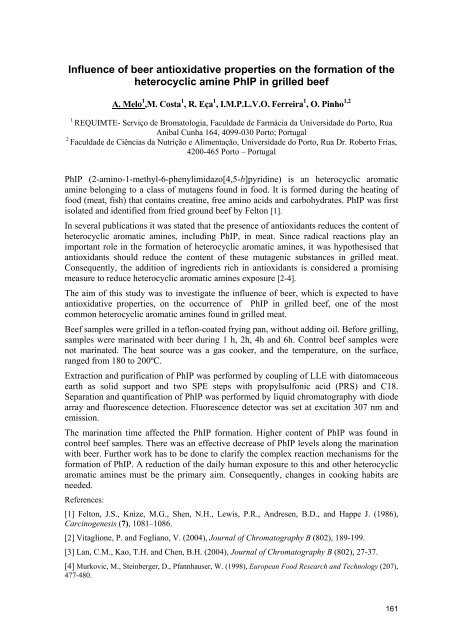IJUP08 - Universidade do Porto
IJUP08 - Universidade do Porto
IJUP08 - Universidade do Porto
- TAGS
- universidade
- porto
- ijup.up.pt
You also want an ePaper? Increase the reach of your titles
YUMPU automatically turns print PDFs into web optimized ePapers that Google loves.
Influence of beer antioxidative properties on the formation of the<br />
heterocyclic amine PhIP in grilled beef<br />
A. Melo 1 ,M. Costa 1 , R. Eça 1 , I.M.P.L.V.O. Ferreira 1 , O. Pinho 1,2<br />
1 REQUIMTE- Serviço de Bromatologia, Faculdade de Farmácia da <strong>Universidade</strong> <strong>do</strong> <strong>Porto</strong>, Rua<br />
Anibal Cunha 164, 4099-030 <strong>Porto</strong>; Portugal<br />
2 Faculdade de Ciências da Nutrição e Alimentação, <strong>Universidade</strong> <strong>do</strong> <strong>Porto</strong>, Rua Dr. Roberto Frias,<br />
4200-465 <strong>Porto</strong> – Portugal<br />
PhIP (2-amino-1-methyl-6-phenylimidazo[4,5-b]pyridine) is an heterocyclic aromatic<br />
amine belonging to a class of mutagens found in food. It is formed during the heating of<br />
food (meat, fish) that contains creatine, free amino acids and carbohydrates. PhIP was first<br />
isolated and identified from fried ground beef by Felton [1].<br />
In several publications it was stated that the presence of antioxidants reduces the content of<br />
heterocyclic aromatic amines, including PhIP, in meat. Since radical reactions play an<br />
important role in the formation of heterocyclic aromatic amines, it was hypothesised that<br />
antioxidants should reduce the content of these mutagenic substances in grilled meat.<br />
Consequently, the addition of ingredients rich in antioxidants is considered a promising<br />
measure to reduce heterocyclic aromatic amines exposure [2-4].<br />
The aim of this study was to investigate the influence of beer, which is expected to have<br />
antioxidative properties, on the occurrence of PhIP in grilled beef, one of the most<br />
common heterocyclic aromatic amines found in grilled meat.<br />
Beef samples were grilled in a teflon-coated frying pan, without adding oil. Before grilling,<br />
samples were marinated with beer during 1 h, 2h, 4h and 6h. Control beef samples were<br />
not marinated. The heat source was a gas cooker, and the temperature, on the surface,<br />
ranged from 180 to 200ºC.<br />
Extraction and purification of PhIP was performed by coupling of LLE with diatomaceous<br />
earth as solid support and two SPE steps with propylsulfonic acid (PRS) and C18.<br />
Separation and quantification of PhIP was performed by liquid chromatography with diode<br />
array and fluorescence detection. Fluorescence detector was set at excitation 307 nm and<br />
emission.<br />
The marination time affected the PhIP formation. Higher content of PhIP was found in<br />
control beef samples. There was an effective decrease of PhIP levels along the marination<br />
with beer. Further work has to be <strong>do</strong>ne to clarify the complex reaction mechanisms for the<br />
formation of PhIP. A reduction of the daily human exposure to this and other heterocyclic<br />
aromatic amines must be the primary aim. Consequently, changes in cooking habits are<br />
needed.<br />
References:<br />
[1] Felton, J.S., Knize, M.G., Shen, N.H., Lewis, P.R., Andresen, B.D., and Happe J. (1986),<br />
Carcinogenesis (7), 1081–1086.<br />
[2] Vitaglione, P. and Fogliano, V. (2004), Journal of Chromatography B (802), 189-199.<br />
[3] Lan, C.M., Kao, T.H. and Chen, B.H. (2004), Journal of Chromatography B (802), 27-37.<br />
[4] Murkovic, M., Steinberger, D., Pfannhauser, W. (1998), European Food Research and Technology (207),<br />
477-480.<br />
161










